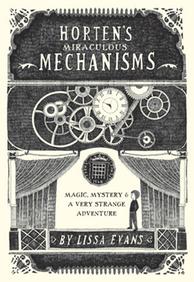Horten's Miraculous Mechanisms by Lissa Evans, illustrated in b&w by Temujin Doran (Sterling, $14.95 hardcover/$7.99 ebook, 9781402798061/9781402798450, 272p., ages 8-12, April 3, 2012)
 In her first book for young readers, Lissa Evans (Their Finest Hour and a Half) combines mystery, comedy and a charming hero in a page-turning middle-grade novel. Her background as a comedy show producer shines through in the impeccable timing of the well-planted clues and sudden revelations--often delivered with a dash of humor.
In her first book for young readers, Lissa Evans (Their Finest Hour and a Half) combines mystery, comedy and a charming hero in a page-turning middle-grade novel. Her background as a comedy show producer shines through in the impeccable timing of the well-planted clues and sudden revelations--often delivered with a dash of humor.
Ten-year-old Stuart Horten is not excited about moving away from his friends to his father's hometown to be near his mother's new job. Not to mention it's the start of summer vacation, and how will he ever meet people his own age? But things start looking up when Stuart's family history turns into a mystery for him to solve, involving his magician Great-Uncle Tony's disappearance years ago. A curious box that Great-Uncle Tony left to Stuart's dad provides a key to unlocking other parts of the puzzle. One of the novel's most charming elements is the relationship between Stuart and his preoccupied father, who designs crossword puzzles and is obsessed with finding the next great word clue and solution (his last bedtime tale for Stuart was about Samuel Johnson and the compilation of the first English dictionary). Stuart, entirely focused on the here and now, almost instantly figures out the secret of the box, which his father has carried around for decades. Yet Stuart's father shows his own talents at a later point, when he helps solve a word clue and also fills in some key facts about the Horten family for Stuart. Their skills complement one another.
On a walk with his father, Stuart learns that his family once ran a factory, Horten's Miraculous Mechanisms, which manufactured locks, safes and coin-operated machinery until it was destroyed in a bombing during World War II. He also finds Great-Uncle Tony's dilapidated dwelling, scheduled for demolition. These settings both figure prominently in Stuart's detective work. But can he shake his next-door neighbor, a girl who's hot on his trail and seems to pop up everywhere, long enough to do his sleuthing? Stuart tries to lose her by taking refuge in a vintage phone booth. The cord's been severed, but still the phone rings. It's the Beeton Public Library, about a book placed on hold for "Mister Horten." Stuart examines the book, filled with photos of the town's landmarks that supply further clues connected to his missing great-uncle. His detective work also leads Stuart to a blind woman, Leonora, the sister of his great-uncle's lovely assistant and fiancée. Leonora seems to be under the thumb of a woman called Jeannie and her sidekick Clifford, who want to find Tony Horten's workshop with all his tricks.
 Meanwhile, the neighbor girl keeps following him! How can she be so omnipresent? Stuart soon discovers it's because she is really three--identical triplets April, May and June Kingley. And April (who distinguishes herself from her siblings by wearing glasses) turns out to be quite helpful to Stuart on his mission--especially when Stuart's parents decide to take a family camping trip the weekend before Uncle Tony's house is to be demolished.
Meanwhile, the neighbor girl keeps following him! How can she be so omnipresent? Stuart soon discovers it's because she is really three--identical triplets April, May and June Kingley. And April (who distinguishes herself from her siblings by wearing glasses) turns out to be quite helpful to Stuart on his mission--especially when Stuart's parents decide to take a family camping trip the weekend before Uncle Tony's house is to be demolished.
Evans creates a winning hero in Stuart Horten, and allows readers to think through the clues right along with him. The humor and logic remain squarely in a 10-year-old mindset. One of the fun ironic twists is that the team trying to find out what happened to Teeny-Tiny Tony Horten doesn't believe in his tricks. "I don't believe in magic," says April. "Nor me," says Stuart, "But neither did Great-Uncle Tony until the night of the fire." Is it all just illusion? The Pharaoh's Cabinet? The Well of Wishes? Ultimately, readers must judge for themselves. A complete, comical and suspenseful ride... to be continued in fall 2012 with Horten's Incredible Illusions.

